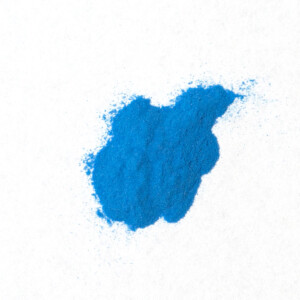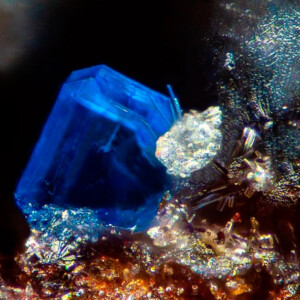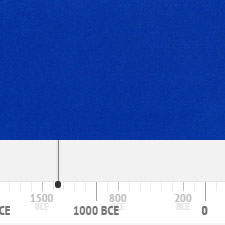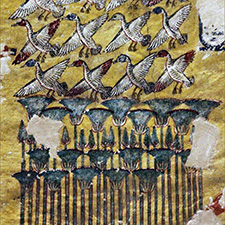Egyptian Blue
The oldest artificial pigmentComposition and Properties of Egyptian Blue
Egyptian blue is an artificial copper calcium silicate with the assumed chemical formula of CaCuSi4O10. The actual composition of samples found at ancient sites varies considerably. It is the oldest synthetic pigment known to Man and its composition, properties, and color are similar to Han blue (BaCuSi2O6) known in imperial China. The mineral cuprorivaite has the same composition but was never used as a pigment.
The pigment is chemically completely stable in all media and is absolutely lightfast. There are no known incompatibilities with other pigments.
Video: 'A Study in Blue Pigments (Part 2) - Egyptian Blue' by Kodner Galleries
Video: 'Nanoscience of an Ancient Pigment' by American Chemical Society
Names
Alternative names
Pompeian blue, Alexandrian blue, Pozzuoli blue, blue frit
Color Index
PB 31, CI 77437
Word origin
Named after Ancient Egypt where it was first produced around 3100 B.C.
Ägyptisch Blau
German
Bleu Egyptien
French
Blu egiziano
Italian
Azul egipcio
Spanish
Preparation
The pigment can be prepared by heating a mixture of a calcium compound (carbonate, sulfate or hydroxide), copper compound (oxide or malachite) and quartz or silica gel in proportions that correspond to a ratio of 4 SiO2 : 1 CaO : 1 CuO to a temperature of 900°C using a flux of sodium carbonate, potassium carbonate or borax. The mixture is then maintained at a temperature of 800°C for a period ranging from 10 to 100 hours.
Note: This recipe does not correspond to the ancient production method of Egyptian blue.
Video: 'Synthesizing the Pigment' by Newfields
References
(1) Davidovits, Frédéric, The Making of Ptolemaic Egyptian Blue Pigment in Latin Texts, Proceedings of the ninth International Congress of Egyptologists, Leuven : Peeters, 2007.
History of Use
The pigment has been in use since the early dynasties of ancient Egypt beginning around 3100 BC (1-3). It was also found in paintings in ancient Greece, India, and Rome. Recently it was identified in medieval and even in Renaissance paintings (4,5).
Tomb of Pharaoh Ay, ca 1320 BC

Wall painting in the tomb of pharao Ay, 18th Dynasty, ca 1320 BC
Image © by Robert Fuchs, University of Applied Sciences, Cologne
Tomb of Pharaoh Haremhab, ca 1300 BC
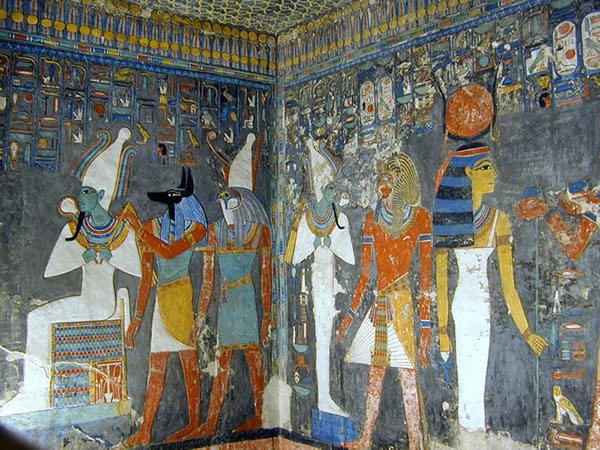
Tomb of Pharaoh Siptah, ca 1190 BC
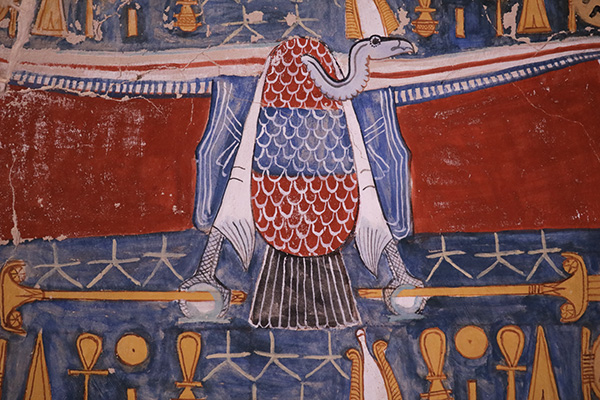
Painted ceiling in the tomb of pharao Siptah, 19th Dynasty, ca 1190 BC
Image © by Robert Fuchs, University of Applied Sciences, Cologne
Video: 'Egyptian Blue on the Parthenon Sculptures, by British Museum
Video: 'The Search for Egyptian Blue' by Yale Campus
References
(1) M. Uda, S. Sassa, S. Yoshimura, J. Kondo, M. Nakamura, Y. Ban, H. Adachi, Yellow, red and blue pigments from ancient Egyptian palace painted walls, Nuclear Instruments and Methods in Physics Research B 161-163 (2000) 758-761. Available as pdf.
(2) Hussein H, Marey Mahmoud, Investigations by Raman microscopy, ESEM and FTIR-ATR of wall paintings from Qasr el-Ghuieta temple, Kharga Oasis, Egypt, Heritage Science, 20142:18, DOI: 10.1186/s40494-014-0018-x.
(3) Monica Ganio, Johanna Salvant, Jane Williams, Lynn Lee, Oliver Cossairt, Marc Walton, Investigating the use of Egyptian Blue in Roman-Egyptian portraits and panels from Tebtunis, Egypt, Appl. Phys. A, DOI 10.1007/s00339-015-9424-5. Available as pdf.
(4) Maria Carolina Gaetani, Ulderico Santamaria and Claudio Seccaroni, The Use of Egyptian Blue and Lapis Lazuli in the Middle Ages: The Wall Paintings of the San Saba Church in Rome, Studies in Conservation, Vol. 49, No. 1 (2004), pp. 13-22.
(5) Jørn Bredal-Jørgensen, Jana Sanyova, Vibeke Rask, Maria Louise Sargent, Rikke Hoberg Therkildsen, Striking presence of Egyptian blue identified in a painting by Giovanni Battista Benvenuto from 1524, Analytical and Bioanalytical Chemistry, September 2011, 401:1433.
Identification
Fiber Optics Reflectance Spectrum (FORS)

Spectra by A. Cosentino, Cultural Heritage Science Open Source (CHSOS)
Infrared Spectrum
Visible and NIR reflectance and fluorescence spectra of Egyptian blue can be found at the website of Bob Fosbury.
Raman Spectrum
Spectrum by Ian M. Bell, Robin J.H. Clark and Peter J. Gibbs, Raman Spectroscopic Library
University College of London
X-Ray Fluorescence Spektrum (XRF)
References
(1) Accorsi, Gianluca, Giovanni Verri, Margherita Bolognesi, Nicola Armaroli, Catia Clementi, Costanza Miliani, and Aldo Romani. The exceptional near-infrared luminescence properties of cuprorivaite (Egyptian blue). Chemical Communications 23 (2009):3392-3394. doi: 10.1039/B902563D.
(2) Verri, Giovanni. “The spatially resolved characterization of Egyptian blue, Han blue and Han purple by photo-induced luminescence digital imaging.” Analytical and bioanalytical chemistry 394, no. 4 (June 2009):1011-1021. doi: 10.1007/s00216-009-2693-0.
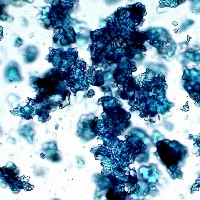
Microphotograph
image © Volker Emrath
Further Reading
References
(1) Josef Riederer, Egyptian blue, in Artists’ Pigments, A Handbook of Their History and Characteristics, Vol 3: E.W. Fitzhugh (Ed.) Oxford University Press 1997, p. 23 – 46. Available as pdf from the National Gallery of Art.
(2) Chase, W T. Egyptian Blue as a Pigment and Ceramic Material. In Science and Archaeology, edited by R. H. Brill. Cambridge: MIT Press, 1971, pp. 80-90.
(3) Tite M. S., M. Bimson, and M. R. Cowell. Technological Examination of Egyptian Blue. In Archaeological Chemistry III, edited by J. B. Lambert. Washington, D.C.: American Chemical Society, 1984, pp. 215-42.
(4) Bayer, G. and Wiedemann, H.G., Bildung und Stabilität von Ägyptisch-Blau (Cuprorivait), Naturwissenschaften 62 (2), (1975), p. 181-2.
(5) Bayer, G. and Wiedemann, H.G., Ägyptisch Blau, ein synthetisches Farbpigment des Altertums, wissenschaftlich betrachtet, Sandoz-Bulletin 40 (1976), p. 20-39.
(6) S. Muntwyler, J. Lipscher, HP. Schneider, Das Farbenbuch, 2nd. Ed., 2023, alataverlag Elsau, pp. 72-73 and 328-331.

